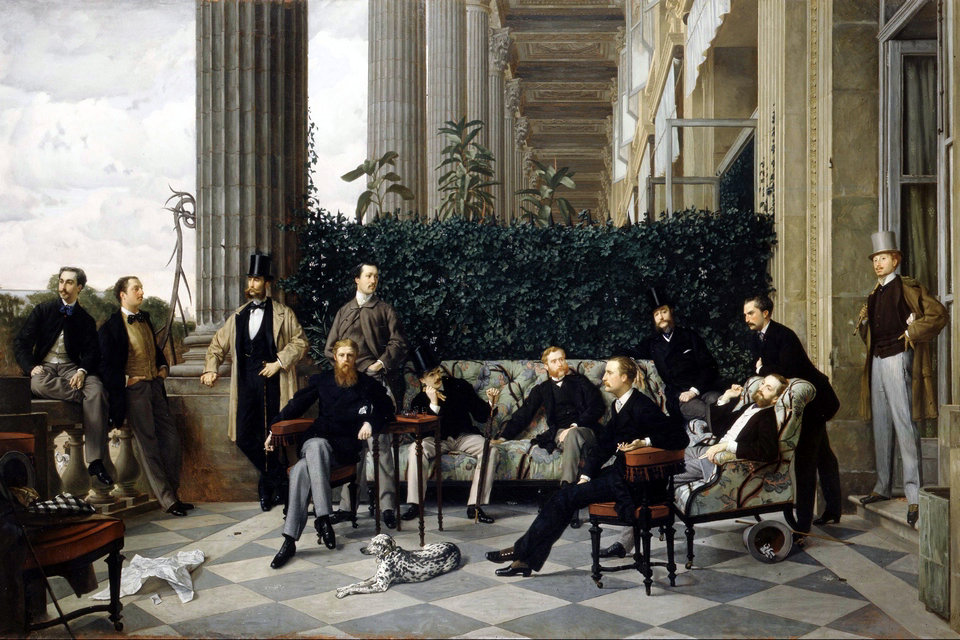

Men’s fashion of the 1860s remained much the same as in the previous decade. From 1860 onwards, the men’s costume consists of a high-closing jacket, straight cardigan and trousers, mostly of the same material. The jacket is straight of model, or slightly longer and fitted with rounded-off pajamas. The legs are wider. The white shirt, symbol of the man who does not work with his hands, has an upright collar and buckled points. The shoes are flat and up to the ankles, with laces. The hair is short, and the man often has a mustache, point or ring beard, and sideburns. In addition to the top hat, the bowler hat (Homburg) and the straw hat are becoming more popular.
The three-piece ditto suit of sack coat, waistcoat, and trousers in the same fabric emerged as a novelty.
Shirts of linen or cotton featured high upstanding or turnover collars, and neckties grew wider and were tied in a bow or looped into a loose knot and fastened with a stickpin. Heavy padded and fitted frock coats (in French redingotes), now usually single-breasted and knee length, were worn for business occasions, over waistcoats or vests with lapels and notched collars. Waistcoats were generally cut straight across the front and had lapels.
The loosely fitted, mid-thigh length sack coat continued to slowly displace the frock coat for less-formal business occasions.
The slightly cutaway morning coat was worn for formal day occasions. The most formal evening dress remained a dark tail coat and trousers, with a white cravat; this costume was well on its way to crystallizing into the modern “white tie and tails”. While during the first half of the decade the waist was long, after 1865 the waist became shorter, with pockets in the pleats.
Full-length trousers were worn, generally of a contrasting fabric. Costumes consisting of a coat, waistcoat and trousers of the same fabric (called a “ditto suit”) remained a novelty at this time. In domestic settings, the sack coat or a lounge jacket could be worn with a waistcoat and trousers of the same fabric. This form of ditto suit, referred to as a lounge suit in the United Kingdom was generally made of wool, with baggy tailoring. However, the lounge suit was not considered appropriate for public settings until the 1870s.
Overcoats had wide lapels and deep cuffs, and often featured contrasting velvet collars.
Top hats briefly became the very tall “stovepipe” shape, but a variety of other hat shapes were popular. During this time, the bowler hat gained popularity as an informal hat. This new type of hat was normally made of felt, black for most of the year or brown for the summer months.
In 1865 hatmaker John B. Stetson invented the Boss of the Plains hat. It gained immediate success in the Old West among cowboys and settlers, due to its practicality. It had a vaguely round ribbon-lined crown and a wide brim, originally straight but soon becoming stylized into the iconic rim of the typical cowboy hat. Its dense felt could be rugged enough to carry water.
Style gallery
| 1 – 1855–65 |
2 – 1860 |
3 – 1860–65 |
4 – 1855–65 |
5 – 1860–65 |
|---|---|---|---|---|
|
6 – 1862 |
7 – 1868 |
1.Eduard de Stoeckl wears a frock coat over a waistcoat with a low front and lapels. He wears a patterned tie. 1855–65.
2.Manet’s unidentified man wears a tie secured with a jewel at the neck, a shawl-collared waistcoat, and a contrasting coat, 1860.
3.George Augustus Sala wears an overcoat with black velvet collar, wide lapels, and deep cuffs over a frock coat, waistcoat, and tweed trousers. He wears leather gloves and carries a top hat. c. 1860–65.
4.William Curtis Noyes wears an overcoat with very wide lapels, wide cuffs, a contrasting (probably velvet) collar, and braid trim over a frock coat, waistcoat, and trousers which appear to be made of matching fabric. The ends of his large necktie are loosely looped and secured with a stickpin, and then tucked into his waistcoat. 1855–65.
5.John Tyler wears a cravat tied in a floppy bow. His coat has wide lapels and contrasting waistcoat have wide lapels, 1860–65.
6.Wilhelm Taubert wears a dark necktie tied in a bow and slightly winged collar. German, 1862.
7.Thomas D’Arcy McGee wears a dark double-breasted frock coat over a high-buttoned single-breasted waistcoat and trousers., 1868.
| 1-1864 |
2-1865 |
3-1864 |
4-1865 |
5-1863 |
|---|---|---|---|---|
|
6-1860s |
7-1863 |
8-1864 |
9-1866 |
10-1860s |
1.Maximilian I of Mexico, 1864, Chapultepec Castle, Mexico City.
2.Emperor Franz Joseph I of Austria, 1865
3.Albert Prince of Wales, later Edward VII of the United Kingdom, 1864
4.Prince Alfred of England, 1865
5.William Douglas 12th Duke of Hamilton, 1863
6.Abraham Lincoln, 1860s
7.Orestes A. Brownson, 1863
8.John Tyler, 1864
9.William Tecumseh Sherman, 1866
10.The Peacemakers, 1860s
| 1-1860 | 2-1862 | 3-1868 | 4-1868 | 5-1868 |
|---|
1.1860 Spanish Singer
2.1862 The Old Musician
3.1868 Portrait of Émile Zola
4.1868 Portrait of Théodore Duret
5.1868 Lunch in the Studio
Source from Wikipedia